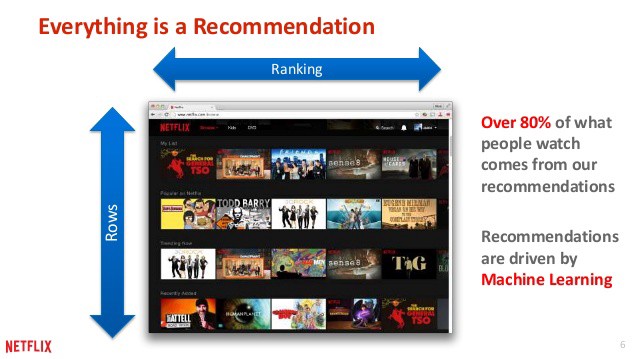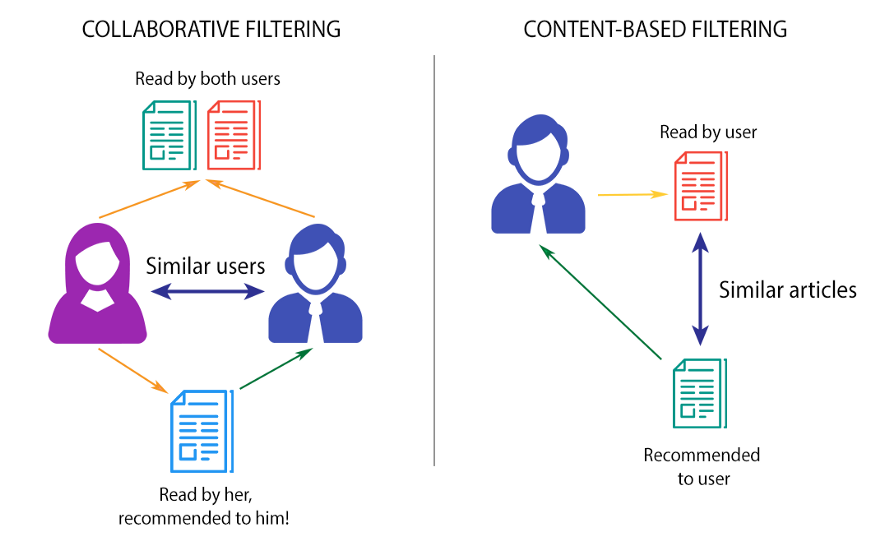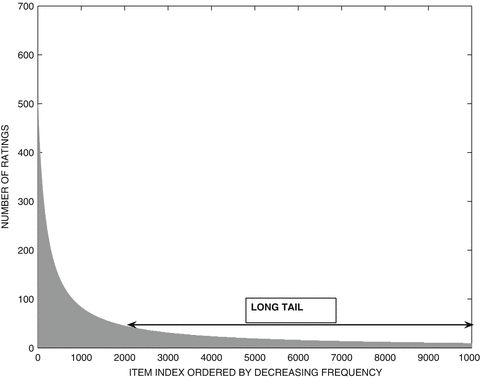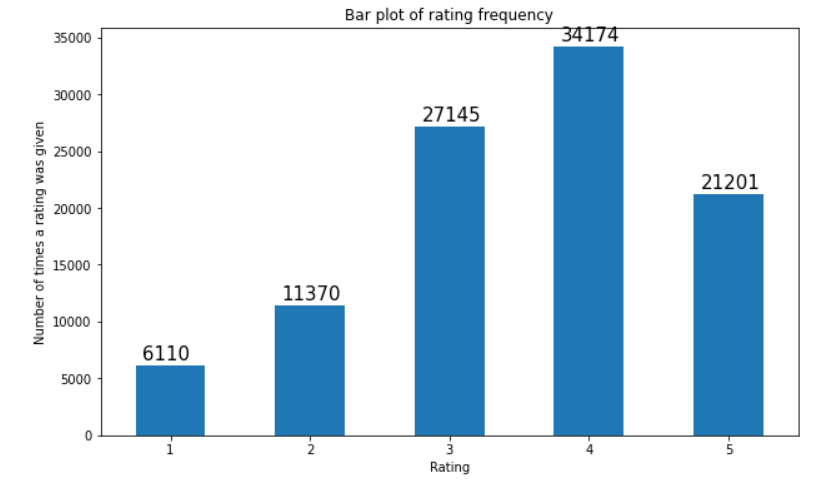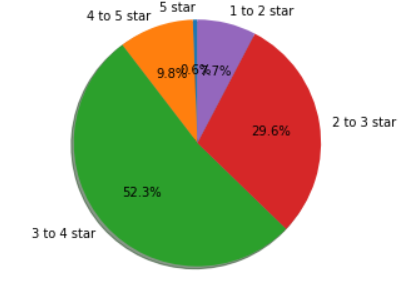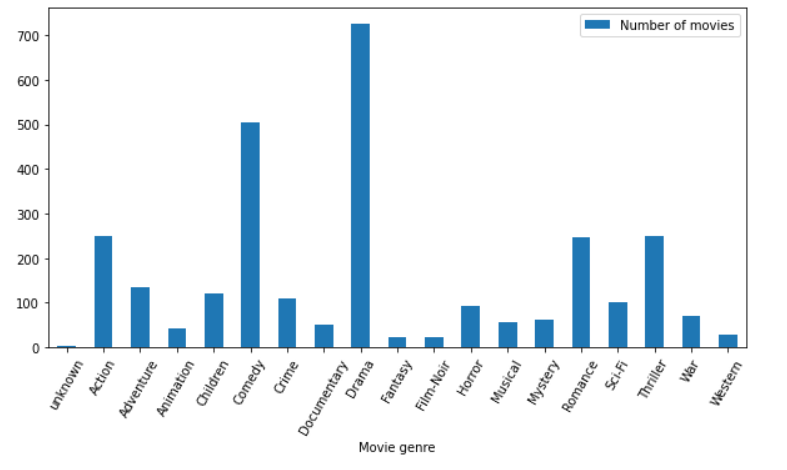[09-01-2023] It's been almost three years since I completed this project and its documentation. Occasionally, I receive connection requests and questions from individuals on LinkedIn. Each time I return to this repository, I'm pleasantly surprised to see people taking an interest in it. This sense of community engagement warms my heart. I wholeheartedly invite all of you who stumble upon this material to connect with me on LinkedIn for any kind of clarifications or questions.
Knowledge-based, Content-based and Collaborative Recommender systems are built on MovieLens dataset with 100,000 movie ratings. These Recommender systems were built using Pandas operations and by fitting KNN, SVD & deep learning models which use NLP techniques and NN architecture to suggest movies for the users based on similar users and for queries specific to genre, user, movie, rating, popularity.
-
Data Visualizations and Manipulations
- Dataframes formed and used
- Reshaping the dataframe
-
Movie Recommender System Development
A recommender system is a subclass of information filtering system that seeks to predict the "rating" or "preference" a user would give to an item. Recommender systems are utilized in a variety of areas including movies, music, news, social tags, and products in general. Recommender systems typically produce a list of recommendations and there are few ways in which it can be done. Two of the most popular ways are – through collaborative filtering or through content-based filtering.
Most internet products we use today are powered by recommender systems. YouTube, Netflix, Amazon, Pinterest, and long list of other internet products all rely on recommender systems to filter millions of contents and make personalized recommendations to their users. Recommender systems are well-studied and proven to provide tremendous values to internet businesses and their consumers.
There are majorly six types of recommender systems which work primarily in the Media and Entertainment industry:
- Collaborative Recommender system
- Content-based recommender system
- Knowledge based recommender system
- Hybrid recommender system
- Demographic based recommender system
- Utility based recommender system
Recommender System is a vast concept rooted from a base idea of giving out suggestions to the users. There are wide range of algorithms are used to build a recommender system and the type of recommender system used is mostly dictated by the type of data available. In this project, first three of the above recommender systems were built.
This approach utilizes a series of discrete characteristics of an item in order to recommend additional items with similar properties. Content-based filtering methods are based on a description of the item and a profile of the user's preferences. To keep it simple, it will suggest you similar movies based on the movie we give (movie name would be the input) or based on all of the movies watched by a user (user is the input). It extracts features of a item and it can also look at the user's history to make the suggestions.
Collaborative filtering is based on the assumption that people who agreed in the past will agree in the future, and that they will like similar kinds of items as they liked in the past. The system generates recommendations using only information about rating profiles for different users or items. By locating peer users/items with a rating history similar to the current user or item, they generate recommendations using this neighborhood. This approach builds a model from a user’s past behaviors (items previously purchased or selected and/or numerical ratings given to those items) as well as similar decisions made by other users. This model is then used to predict items (or ratings for items) that the user may have an interest in. Collaborative filtering methods are classified as memory-based and model-based.
These are based on explicit knowledge about the item assortment, user preferences, and recommendation criteria (i.e., which item should be recommended in which context). These systems are applied in scenarios where alternative approaches such as collaborative filtering and content-based filtering cannot be applied. In simple terms, knowledge based recommender system can be used to suggest content/item to a new user or an anonymous user who doesn't have any history.
This combines more than one of these techniques to resolve one or more problems. This approach can be used to overcome some of the common problems in recommender systems such as cold start and the sparsity problem in collaborative approach, as well as the knowledge engineering bottleneck in knowledge-based approaches. It is proved that hybrid recommender system performs extremely well compared to pure collaborative and content based methods.
In this project, three of the above recommender systems were build using different algorithms. Following challenges were encountered while building these recommender systems:
- cold start
- data sparsity
- popular bias (how to recommend products from the tail of product distribution)
- User Inconvinience with spelling while giving movie names as input (can't expect to give exact movie name everytime)
- scalability (computation grows as number of users and items grow)
- pool relationship between like-minded yet sparse users
Above chart is the distribution of item rating frequency. This distribution often satisfies a property in real-world settings, which is referred to as the long-tail property [1]. According to this property, only a small fraction of the items are rated frequently. Such items are referred to as popular items. The vast majority of items are rated rarely.
In most cases, high-frequency items tend to be relatively competitive items with little profit for the merchant. On the other hand, the lower frequency items have larger profit margins. However, many recommendation algorithms have a tendency to suggest popular items rather than infrequent items. This phenomenon also has a negative impact on diversity, and users may often become bored by receiving the same set of recommendations of popular items
A solution for long-tail could be Use matrix factorization technique to train model to learn user-item interaction by capturing user information in user latent factors and item information in item latent factors. Meanwhile, matrix factorization technique can significantly reduce dimensionality and sparsity and it will reduce huge amount of memory footprint and make our system more scalable
MovieLens 100K dataset has been used for this project. MovieLens is a rating dataset from the MovieLens website, which has been collected over some period. Stable benchmark dataset. 100,000 ratings from 1000 users on 1700 movies. Released on 4/1998. Further information regarding this dataset can be found here.
A little about the dataset:
MovieLens data sets were collected by the GroupLens Research Project at the University of Minnesota.
This data set consists of:
- 100,000 ratings (1-5) from 943 users on 1682 movies.
- Each user has rated at least 20 movies.
- Simple demographic info for the users (age, gender, occupation, zip)
About few components loaded from the package which are used in this project:
- u.data -- The full u data set, 100000 ratings by 943 users on 1682 items. Each user has rated at least 20 movies. Users and items are numbered consecutively from 1. The data is randomly ordered. This is a tab separated list of user id | item id | rating | timestamp.
- u.info -- The number of users, items, and ratings in the u data set.
- u.item -- Information about the items (movies); this is a tab separated list of movie id | movie title | release date | video release date | IMDb URL | unknown | Action | Adventure | Animation | Children's | Comedy | Crime | Documentary | Drama | Fantasy | Film-Noir | Horror | Musical | Mystery | Romance | Sci-Fi | Thriller | War | Western |
The last 19 fields are the genres, a 1 indicates the movie is of that genre, a 0 indicates it is not; movies can be in several genres at once.The movie ids are the ones used in the u.data data set.
- u.genre -- A list of the genres.
Data has been loaded into dataframes using pandas. It had been analyzed and visualized to draw some key insights before going further into recommendations.
Observation: We can observe that most of the users have rewarded movies they watched with a 4 star rating and followed by 3 star and 5 star.
The same has been displayed below using a pie chart to understand the constributions.
Genre based number of movies count is being plotted using bar-graph:
We can see that most of the movies belong to movie genre : Drama followed by Comedy then Action, Romance and Thriller
items_dataset (movie id, movie name, and all genres); dataset (user id, movie id, rating); movie_dataset is a subset of items_dataset (it has movie id, movie name); Both movie_dataset and dataset are merged based on movie id and new merged_dataset is formed (user id, movie id, rating, movie name); a new dataframe is formed by averaging the overall rating available to a movie from the merged_dataset, are sorted with descending order of ratings and is named avg_rating_dataset (movie name, avg rating); There are few movie titles which have multiple movie id's causing duplicate combinations of movie id & title, these duplicate entries are caused when an user gives rating to a movie more than one time. These duplicate ratings are merged into single row by averaging the available ratings.
Recommendations are made based on the available items and their corresponding ratings data, considering we have no user data available.
Data manipulations are done using Pandas
- A General recommendations of movies made based on high average ratings:
movie title avg rating
Marlene Dietrich: Shadow and Light (1996) 5.0
Prefontaine (1997) 5.0
Santa with Muscles (1996) 5.0
Star Kid (1997) 5.0
Someone Else's America (1995) 5.0
Entertaining Angels: The Dorothy Day Story (1996) 5.0
Saint of Fort Washington, The (1993) 5.0
These are the top 7 movies that can be naviely suggested to the new users, Recommendations based on top average ratings.
- Movie Recommendations based on popularity :
We have considered movies which have more than 400 viewers as POPULAR and there are 12 movies.
movie title Number of Users watched
Star Wars (1977) 583
Contact (1997) 509
Fargo (1996) 508
Return of the Jedi (1983) 507
Liar Liar (1997) 485
English Patient, The (1996) 481
Scream (1996) 478
Toy Story (1995) 452
Air Force One (1997) 431
Independence Day (ID4) (1996) 429
Raiders of the Lost Ark (1981) 420
Godfather, The (1972) 413
These are the most popular movies which can be recommended to a new user. Recommendations based on Popularity
Above two recommendations are good enough but are not complete and may not interest many of the new users
- Movie Recommendations based on both popular and average ratings. Recommendations based popularity and rating. These are top rated popular movies
movie title avg rating Number of Users watched
Star Wars (1977) 4.358491 583
Silence of the Lambs, The (1991) 4.289744 390
Godfather, The (1972) 4.283293 413
Raiders of the Lost Ark (1981) 4.252381 420
Titanic (1997) 4.245714 350
Empire Strikes Back, The (1980) 4.204360 367
Princess Bride, The (1987) 4.172840 324
Fargo (1996) 4.155512 508
Monty Python and the Holy Grail (1974) 4.066456 316
1Pulp Fiction (1994) 4.060914 394
4Fugitive, The (1993) 4.044643 336
9Return of the Jedi (1983) 4.007890 507
These movies are the best to suggest to a new user as they are popular and well rated by the users who already watched them. These have rating more than 4 with atleast 300 viewers. (the threshold for ratings and number of viewers can be changed accordingly based on the data available)
- Movie suggestions based on specific Genre picked by the user
For every genre, Genre wise ratings are plotted using bar plot and the above mentioned three types of movie recommendations are given out in specific to the selected genre.
Below are the two such examples for genres: Action and Animation
**************************** ****** GENRE: Action ****** ******************************
Total number of users watched this Genre: 25589
These are the top movies that can be naviely suggested to the new users for the requested movie genre: Action . Recommendations based on top average ratings.
rating
movie title
Star Wars (1977) 4.358491
Godfather, The (1972) 4.283293
Raiders of the Lost Ark (1981) 4.252381
Titanic (1997) 4.245714
Empire Strikes Back, The (1980) 4.204360
Boot, Das (1981) 4.203980
Godfather: Part II, The (1974) 4.186603
African Queen, The (1951) 4.184211
Princess Bride, The (1987) 4.172840
Braveheart (1995) 4.151515
**************************** ****************************** ******************************
These are the most popular movies which can be recommended to a new user in Action genre. Recommendations based on Popularity
movie title Number of Users watched
0 Star Wars (1977) 583
1 Return of the Jedi (1983) 507
2 Air Force One (1997) 431
3 Independence Day (ID4) (1996) 429
4 Raiders of the Lost Ark (1981) 420
5 Godfather, The (1972) 413
6 Rock, The (1996) 378
7 Empire Strikes Back, The (1980) 367
8 Star Trek: First Contact (1996) 365
9 Titanic (1997) 350
**************************** ****************************** ******************************
These movies are the best to suggest to a new user within their requested genre as they are popular and well rated by the users who already watched them.
These have rating more than 4.0 with atleast 250 viewers.
**Recommendations based popularity and rating. These are top rated popular movies**
movie title rating Number of Users watched
0 Star Wars (1977) 4.358491 583
1 Godfather, The (1972) 4.283293 413
2 Raiders of the Lost Ark (1981) 4.252381 420
3 Titanic (1997) 4.245714 350
4 Empire Strikes Back, The (1980) 4.204360 367
8 Princess Bride, The (1987) 4.172840 324
9 Braveheart (1995) 4.151515 297
11 Fugitive, The (1993) 4.044643 336
12 Alien (1979) 4.034364 291
13 Return of the Jedi (1983) 4.007890 507
14 Terminator 2: Judgment Day (1991) 4.006780 295
**************************** ****************************** ******************************
**************************** ****** GENRE: Animation ****** ******************************
Total number of users watched this Genre: 3605
These are the top movies that can be naviely suggested to the new users for the requested movie genre: Animation . Recommendations based on top average ratings.
rating
movie title
Close Shave, A (1995) 4.491071
Wrong Trousers, The (1993) 4.466102
Wallace & Gromit: The Best of Aardman Animation... 4.447761
Faust (1994) 4.200000
Grand Day Out, A (1992) 4.106061
Toy Story (1995) 3.878319
Aladdin (1992) 3.812785
Winnie the Pooh and the Blustery Day (1968) 3.800000
Beauty and the Beast (1991) 3.792079
Lion King, The (1994) 3.781818
**************************** ****************************** ******************************
These are the most popular movies which can be recommended to a new user in Animation genre. Recommendations based on Popularity
movie title Number of Users watched
0 Toy Story (1995) 452
1 Lion King, The (1994) 220
2 Aladdin (1992) 219
3 Beauty and the Beast (1991) 202
4 Fantasia (1940) 174
5 Snow White and the Seven Dwarfs (1937) 172
6 Beavis and Butt-head Do America (1996) 156
7 Cinderella (1950) 129
8 Hunchback of Notre Dame, The (1996) 127
9 James and the Giant Peach (1996) 126
**************************** ****************************** ******************************
These movies are the best to suggest to a new user within their requested genre as they are popular and well rated by the users who already watched them.
These have rating more than 2.5 with atleast 100 viewers.
**Recommendations based popularity and rating. These are top rated popular movies**
movie title rating Number of Users watched
0 Close Shave, A (1995) 4.491071 112
1 Wrong Trousers, The (1993) 4.466102 118
5 Toy Story (1995) 3.878319 452
6 Aladdin (1992) 3.812785 219
8 Beauty and the Beast (1991) 3.792079 202
9 Lion King, The (1994) 3.781818 220
10 Fantasia (1940) 3.770115 174
11 Snow White and the Seven Dwarfs (1937) 3.709302 172
12 Pinocchio (1940) 3.673267 101
15 Cinderella (1950) 3.581395 129
17 Dumbo (1941) 3.495935 123
20 Hunchback of Notre Dame, The (1996) 3.377953 127
26 James and the Giant Peach (1996) 3.126984 126
33 Beavis and Butt-head Do America (1996) 2.788462 156
**************************** ****************************** ******************************
Rating frequency as bar plot, movie recommendation based on only high ratings, only popularity and high rated popular movie for each movie genre separately.
The thresholds for ratings and number of viewers for a movie to be considered for high rated popular movie catedory are selected dynamically based on the total viewers and it these limits differ from genre to genre
KNN algorithm is used to determine the corresponding similar movie or a user based on cosine similarity. K value is defined and desired number of nearest neighboring movies/users are returned.
Datasets are loaded and similar EDA was performed as described above. A new dataset is created from the existing merged dataset by grouping the unique user id and movie title combination and the ratings by a user to the same movie in different instances (timestamps) are averaged and stored in the new dataset.
An example of a multiple rating scenario by an user to a specific movie:
user id movie id rating timestamp movie title
894 246 4 882404137 Chasing Amy (1997)
894 268 3 879896041 Chasing Amy (1997)
For a KNN algorithm to implement, we have to form a matrix from the available data.
From the EDA, we have observed that there are huge number of missing ratings. The matrix formed would be a sparse matrix with most of the entries having 0 in it.
We need to transform (reshape in this case) the data in such a way that each row of the dataframe represents a movie and each column represents a different user. So we want the data to be [movies, users] array if movie is the subject where similar movies must be found and [users, movies] array for reverse.
To reshape the dataframe, we will pivot the dataframe to the wide format with movies as rows and users as columns. As we know that not all users watch all the movies, we can expect a lot of missing values. We will have to fill those missing observations with 0s since we are going to perform linear algebra operations (calculating distances between vectors).
Finally, we transform the values of the dataframe into a scipy sparse matrix for most efficient calculations.
This dataframe is then fed into a KNN model.
Two types of Collaborative recommendations are done using KNN algorithm in this project are:
Movie Recommendation using KNN with Input as User id, Number of similar users should the model pick and Number of movies you want to get recommended:
Reshaping the dataframe in such a way that each user has n-dimensional rating space where n is total number of movies
We will train the KNN model inorder to find the closely matching similar users to the user we give as input and we recommend the top movies which would interest the input user.
- Now we need to pick similar users for the given input User id
- Then pick the highly rated popular movies among the movies watched by similar users. (Weightage has assigned based on the cosine distance)
- Excluding the movies which are already seen by the input User and also the movies which are not at all seen by any of the similar users but are still in the list. (This is a crucial step as it could defeat the whole point of building a recommender system)
With the help of the KNN model built, we could get desired number of top similar users. For example, lets's consider User: 778
Few of movies seen by the User:
['Amityville Horror, The (1979)',
'Angels in the Outfield (1994)',
'Apocalypse Now (1979)',
'Apollo 13 (1995)',
'Austin Powers: International Man of Mystery (1997)',
'Babe (1995)',
'Back to the Future (1985)',
'Blues Brothers, The (1980)',
'Chasing Amy (1997)',
'Clerks (1994)']
Top 5 users who are very much similar to the User- 778 are:
1 . User: 124 separated by distance of 0.4586649429539592
2 . User: 933 separated by distance of 0.5581959868865324
3 . User: 56 separated by distance of 0.5858413112292744
4 . User: 738 separated by distance of 0.5916272517988691
5 . User: 653 separated by distance of 0.5991479757406326
Now we will have to pick the top movies to recommend.
One way would be by taking the average of the existing ratings given by the similar users and picking the top 10 or 15 movies to recommend to our current user.
But I feel recommendation would be more effective if we define weights to ratings by each similar user based on the thier distance from the input user. Defining these weights would give us the accurate recommendations by eliminating the chance of decision manipulation by the users who are relatively very far from the input user.
Functionality was defined to overcome below Challenges:
- Recommends movies which are already seen by the given input User.
- There is a possibility of recommending the movies which are not at all seen by any of the similar users.
*Results for a User id: 307; number of similar users to be considered: 15; Enter number of movies to be recommended: 15 are:
Top 15 users who are very much similar to the User- 307 are:
1 . User: 70 separated by distance of 0.4560883724650484
2 . User: 738 separated by distance of 0.4846662001127756
3 . User: 922 separated by distance of 0.503221313979523
4 . User: 407 separated by distance of 0.5038250337403114
5 . User: 514 separated by distance of 0.5060750098353226
6 . User: 44 separated by distance of 0.5160506271876224
7 . User: 660 separated by distance of 0.5165826487301209
8 . User: 5 separated by distance of 0.5211146313938015
9 . User: 457 separated by distance of 0.5309167131718452
10 . User: 23 separated by distance of 0.5316197783536492
11 . User: 843 separated by distance of 0.5324703658288387
12 . User: 64 separated by distance of 0.53318921205275
13 . User: 198 separated by distance of 0.535682894616484
14 . User: 815 separated by distance of 0.5416036160331636
15 . User: 95 separated by distance of 0.5468066886836396
Movies recommended based on similar users are:
["Schindler's List (1993)",
'Liar Liar (1997)',
'When Harry Met Sally... (1989)',
'Leaving Las Vegas (1995)',
'Silence of the Lambs, The (1991)',
'Dead Man Walking (1995)',
'Trainspotting (1996)',
'Forrest Gump (1994)',
'Scream (1996)',
'Twelve Monkeys (1995)',
'Jerry Maguire (1996)',
'Raising Arizona (1987)',
'Godfather, The (1972)',
'Rock, The (1996)',
'Fugitive, The (1993)']
Movie Recommendation using KNN with Input as Movie Name and Number of movies you want to get recommended:
Reshaping model in such a way that each movie has n-dimensional rating space where n is total number of users who could rate.
We will train the KNN model inorder to find the closely matching similar movies to the movie we give as input and we recommend the top movies which would more closely align to the movie we have given.
For this section, a separate list for movie names and also case insensitive movie names and a dictionary which maps movie name with the index are created.
Basic output of this recommender system using KNN:
Top 10 movies which are very much similar to the Movie- 101 Dalmatians (1996) are:
Jack (1996)
Twister (1996)
Willy Wonka and the Chocolate Factory (1971)
Independence Day (ID4) (1996)
Toy Story (1995)
Father of the Bride Part II (1995)
Hunchback of Notre Dame, The (1996)
Lion King, The (1994)
Mrs. Doubtfire (1993)
Jungle Book, The (1994)
Key Challenge which needs to be addressed in this segment is not recommending the similar movie names, it is to let the user give the movie name with correct spelling
To address this challenge, a new functionality has been written.
Dynamic movie name Suggestions for the User (through User Interface) A functionality was designed to dynamically suggesting movie name from the existing movie corpus we have, based on the user input using try and except architecture.
A function which outputs movie names as suggestion when the user mis spells the movie name. User might have intended to type any of these movie names.
This function provides user with movie name suggestions if movie name is mis-spelled or Recommends similar movies to the input movie if the movie name is valid.
Results of the Recommender System built using KNN along with Dynamic Suggestor:
Enter the Movie name: back
Entered Movie name is not matching with any movie from the dataset . Please check the below suggestions :
['Back to the Future (1985)', 'Backbeat (1993)', 'Best of the Best 3: No Turning Back (1995)', 'Empire Strikes Back, The (1980)', 'Hunchback of Notre Dame, The (1996)', 'Switchback (1997)']
Enter the Movie name: Empire Strikes Back, The (1980)
Enter Number of movie recommendations needed: 15
Top 15 movies which are very much similar to the Movie- Empire Strikes Back, The (1980) are:
Raiders of the Lost Ark (1981)
Indiana Jones and the Last Crusade (1989)
Back to the Future (1985)
Star Wars (1977)
Terminator, The (1984)
Return of the Jedi (1983)
Terminator 2: Judgment Day (1991)
Princess Bride, The (1987)
Jurassic Park (1993)
Fugitive, The (1993)
Silence of the Lambs, The (1991)
E.T. the Extra-Terrestrial (1982)
Star Trek: The Wrath of Khan (1982)
Alien (1979)
Blade Runner (1982)
Observations: on above built KNN Recommender System:
An interesting observation would be that the above KNN model for movies recommends movies that are produced in very similar years of the input movie. However, the cosine distance of all those recommendations are observed to be actually quite small. This might be because there are too many zero values in our movie-user matrix. With too many zero values in our data, the data sparsity becomes a real issue for KNN model and the distance in KNN model starts to fall apart.
Matrix Factorization is simply a mathematical operation for matrices. It is usually more effective in collaborative filtering, because it allows us to discover the latent (hidden) features underlying the interactions between users and items (movies).
Utility matrix has been formed from the existing merged dataframe and normalized across the entity (movie or user) with which you want find the similarity.
Singular Value Decomposition is done on utility matrix and latent features of rows and columns (movies and users in this case). In SVD decomposition, Where A is a m x n utility matrix, U is a m x r orthogonal left singular matrix, which represents the relationship between users and latent factors, S is a r x r diagonal matrix, which describes the strength of each latent factor and V is a r x n diagonal right singular matrix, which indicates the similarity between items and latent factors. The latent factors here are the characteristics of the items, for example, the genre of the music. The SVD decreases the dimension of the utility matrix A by extracting its latent factors. It maps each user and each item into a r-dimensional latent space. This mapping facilitates a clear representation of relationships between users and items/movies.
SVD reduces the dimensionality reduction and gets us important latent features which can almost approximate all values in the utility matrix (including null values). Already available values in the utility matrix can be used to evaluate the predictions and tune the parameters/weights in the latent features (if matrix factorization used) or help us to pick the number of latent features from the SVD decomposition. Once number of latent features to be picked are decided, we can populate the null values and use these predicted ratings of a user for movie to recommend the movie with highest predicted rating to that particular user.
A function is defined to calculate the cosine similarity on the given dataframe and extracting requesting number of closely matched movie indices with the help of numpy einsum which valuates the Einstein summation convention on the operands. Dynamic movie name suggestor discussed above is also used as part of user interactive interface.
Movie Recommendations using SVD giving a movie name as input:
Enter the Movie name: dal
Entered Movie name is not matching with any movie from the dataset . Please check the below suggestions :
['101 Dalmatians (1996)', 'Mrs. Dalloway (1997)']
Enter the Movie name: 101 Dalmatians (1996)
Enter Number of movie recommendations needed: 10
Top 10 movies which are very much similar to the Movie- 101 Dalmatians (1996) are:
Black Beauty (1994)
Free Willy 2: The Adventure Home (1995)
Evening Star, The (1996)
Robin Hood: Men in Tights (1993)
Cool Runnings (1993)
Turbo: A Power Rangers Movie (1997)
Remains of the Day, The (1993)
City Hall (1996)
Children of the Corn: The Gathering (1996)
Some limitations of matrix factorization include:
- The difficulty of using side features (that is, any features beyond the query ID/item ID). As a result, the model can only be queried with a user or item present in the training set.
- Relevance of recommendations. Popular items tend to be recommended for everyone, especially when using dot product as a similarity measure. It is better to capture specific user interests.
- The matrix factorization also had the cold start problem due to the fact that it had no feature vector or embedding for the new items.
- Matrix factorization works on the simple inner product of the User and item feature embeddings, it is often not enough to capture and represent the complex relations in the user and items.
The above mentioned limitations of matrix factorization can be addressed with the help of Deep Neural Network (DNN) models. Due to flexibility of the input layer of network, DNNs can easily incorporate query features and item features which can help capture the specific interests of a user and improve the relevance of recommendations.
There are different types of Deep Neural Networks applications like DNN with Softmax layer, DNN with Autoencoder architecture or may it be Recommender System with Wide & Deep Neural Networks that can be applied to Recommender Systems for better movies to recommend.
For this project, Softmax Deep Neural Networks are used to recommend movies. Users and Movies are one-hot encoded and fed into the Deep Neural Network as different distinct inputs and ratings are given as output.
Deep Neural Network model was built by extracting the latent features of Users and movies with the help of Embedding layers and then Dense layers with dropouts were stacked in the end and finally a Dense layer with 9 neurons (one for each possible rating from 1 to 5) with a Softmax activation function was added.
Hyperparmeters of the model were tuning, many loss functions and optimizers were tried with minimum validation loss as metric to built the model and get the weights.
Finally, 'SGD' for optimizer and Sparse Categorical Cross entropy for loss function were picked.
User id is taken as input from the User. Then the movie ids which were not already seen by extracted from the available dataframe.
How this DNN model works is, it takes two inputs, one of the input has user id's and the other has corresponding movie id's. Here DNN model tries to predict the ratings of the user - movie combination. So, we can input a specific user id (broadcasting it with the size of other input) and unseen movie id of the user and expect the model to give the ratings of the movies which would have been the ratings given by the user. Here, the ratings are already normalized and as we need the movies which interest the user more, ratings are not brought back to 0-5 scale.
DNN model is used to predict the ratings of the unseen movies.
Predicted Ratings:
[[6.28711879e-01 3.71125787e-01 1.93846718e-05 ... 2.48171236e-05
2.07571484e-05 3.11595759e-05]
[5.16196430e-01 4.83636826e-01 2.06636632e-05 ... 2.40022491e-05
2.14833890e-05 3.09596326e-05]
...
[6.53564811e-01 3.46285373e-01 1.90432311e-05 ... 2.25746426e-05
1.92296520e-05 2.91551714e-05]]
Output is of shape (1628, 9). We got probability of each possible rating from 1 to 5. We can extract specific rating which user would have given to a movie but it is not useful for these recommendations now.
array([0.6287119, 0.5161964, 0.8921049, ..., 0.6535648, 0.577208 ,
0.6869574], dtype=float32)
These predicted pseudo-ratings of the user for the unseen movies are sorted with highest ratings in the first and these labels are inverse transformed to get desired number of Movie names.
Movie Recommendations using Softmax Deep Neural Network given user id as input:
Enter user id
307
Enter number of movies to be recommended:
15
Movie seen by the User:
['12 Angry Men (1957)',
'2001: A Space Odyssey (1968)',
'Abyss, The (1989)',
'Alien (1979)',
'Apollo 13 (1995)',
'Boot, Das (1981)',
'Brady Bunch Movie, The (1995)',
'Braveheart (1995)',
'Brazil (1985)',
'Casablanca (1942)',
'Close Shave, A (1995)',
'Contact (1997)',
'E.T. the Extra-Terrestrial (1982)',
'Empire Strikes Back, The (1980)',
'English Patient, The (1996)',
'Englishman Who Went Up a Hill, But Came Down a Mountain, The (1995)',
'Escape from L.A. (1996)',
'Fargo (1996)',
...
...
'Sex, Lies, and Videotape (1989)',
'Shadowlands (1993)',
'Shawshank Redemption, The (1994)',
'Shining, The (1980)',
'Sneakers (1992)',
'Snow White and the Seven Dwarfs (1937)',
'Sound of Music, The (1965)',
'Stand by Me (1986)',
'Star Trek III: The Search for Spock (1984)',
'Star Trek IV: The Voyage Home (1986)',
'Star Trek: The Motion Picture (1979)',
'Star Trek: The Wrath of Khan (1982)',
'Star Wars (1977)',
'Stargate (1994)',
'Tank Girl (1995)',
'Terminator, The (1984)',
'This Is Spinal Tap (1984)',
'Titanic (1997)',
'To Kill a Mockingbird (1962)',
'Top Gun (1986)',
'Toy Story (1995)',
'Wallace & Gromit: The Best of Aardman Animation (1996)',
'Wizard of Oz, The (1939)',
'Wrong Trousers, The (1993)']
Top 15 Movie recommendations for the User 307 are:
['Speed 2: Cruise Control (1997)',
'Houseguest (1994)',
'Batman & Robin (1997)',
'Magic Hour, The (1998)',
"Devil's Advocate, The (1997)",
'Gone with the Wind (1939)',
'Cobb (1994)',
'Cool Runnings (1993)',
'Independence Day (ID4) (1996)',
'Smoke (1995)',
'Once Were Warriors (1994)',
'True Romance (1993)',
'Red Rock West (1992)',
'Third Man, The (1949)',
'MatchMaker, The (1997)']


